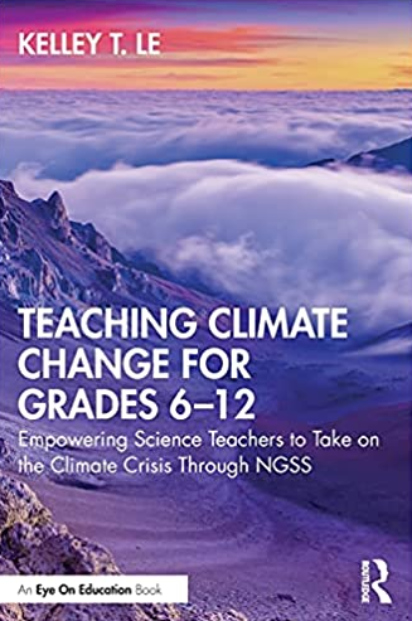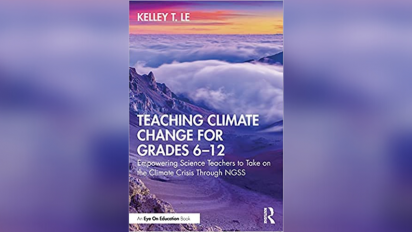[Review] Teaching Climate Change for Grades 6–12
"Teaching Climate Change for Grades 6–12 deserves a place on the bookshelf of science teachers who want to improve the effectiveness of their efforts to teach climate science accurately, honestly, and thoroughly," writes our reviewer Glenn Branch.
As the evidence for the reality and the seriousness of anthropogenic climate change continues to accumulate, American science education is slowly pivoting. As of 2020, 20 states (plus the District of Columbia) had adopted the Next Generation Science Standards, which highlight global climate change as one of four sub-ideas in the core idea of Earth and Human Activity at both the middle school and the high school level; a further six states had adopted standards that treat climate change at least as well, according to a 2020 study from NCSE and the Texas Freedom Network Education Fund. Yet in the first nationally representative survey of public middle and high school science educators, conducted by researchers at NCSE and Penn State in 2014– 2015, a majority — 57.1 percent — reported that they had received no formal instruction on climate change during their pre-service coursework.

Clearly, then, there is a need to equip science teachers to teach climate science effectively. Teaching Climate Change for Grades 6–12, written by a former classroom science teacher who now directs the Science Project at the University of California, Irvine, is aimed primarily at in-service teachers seeking to integrate climate change in their curricula. Kelley T. Le (interviewed as part of our Random Samples series) addresses her intended audience familiarly — “Let’s begin with what you know, care about, and take action on,” she suggests (p. 2) — and offers multiple opportunities, in the form of “exhibit” sidebars, for her readers to pause and reflect on their knowledge, attitudes, and practices regarding climate change and climate change education. Each chapter is also supplemented by quotations from various luminaries in climate change education — including NCSE’s Lin Andrews (p. 66) — a selection of teacher resources (usually available online), and a list of references.
After a foreword by NOAA’s Frank Niepold and Le’s introduction, the book is divided into three parts — ”Looking Back to Move Forward”; “Developing Scientific Literacy Using Climate Science”; and “Practices to Build Capacity for Student Agency” — containing two chapters apiece. The first of these parts emphasizes the novelty of the NGSS, focusing on their encouragement of inquiry-based learning, their treatment of the nature of science, and their amenability to equity education, before turning to climate change in the NGSS in particular. Le argues that the NGSS is particularly supportive of teaching climate change for reasons involving both the scientific content and the pedagogical approach of the NGSS: “Nearly one-third of the NGSS relates directly or indirectly to climate change content,” she observes, adding that, owing to its socially controversial nature, it is “the ideal vehicle” to learn about the nature of science (pp. 53, 57).
The second part of the book sketches the basics of climate science and offers five excellent takeaways, based on up-to-date research in science education, about how to teach climate change effectively. In summary:
- Teach the scientific consensus on climate change.
- Do not debate about climate change.
- Teach climate change through the lens of systems thinking.
- Teach climate change as a socioscientific issue.
- Teach the cause of current climate change along with the need to seek diverse and intersectional solutions. (pp. 98–99)
Le then develops her argument that climate change is particularly apt for teaching about the nature of science, a central aspect of scientific literacy, within the framework of the NGSS, with specific advice about anchoring phenomena, investigative phenomena, and storylining.
Finally, in the third part of the book, Le describes ways to develop and iteratively improve lessons with meaningful storylines before turning — a bit awkwardly — to a discussion of helping students to evaluate misinformation and disinformation in the media, including the Heartland Institute’s climate change denial efforts. Given the abundance of such misleading sources of information and their influence over students and their communities, which Le explicitly acknowledges, a longer discussion would have been welcome. The final chapter, “Education for Climate Action,” addresses teachers who want to help their students get involved in taking action on climate change. While the suggestions here are generally sensible, there is no acknowledgement of the possibility of ideological backlash against the idea of teaching for climate action, which teachers should be aware of though not cowed by.
Teaching Climate Change for Grades 6–12 amply succeeds in its ambition to empower science teachers to take on the climate crisis through NGSS (to paraphrase the book’s subtitle), thanks not only to its informed content but also to the thoughtful approach to communicating with the intended audience. Le offers practical guidance in terms that science teachers will understand and can put to use. By the same token, however, readers who are not themselves science teachers and thus not as interested in and conversant with pedagogical considerations may find the book less than appealing. But along with the Paleontological Research Institute’s excellent The Teacher-Friendly Guide to Climate Change (2017), Teaching Climate Change for Grades 6–12 deserves a place on the bookshelf of science teachers who want to improve the effectiveness of their efforts to teach climate science accurately, honestly, and thoroughly.
This version might differ slightly from the print publication.





